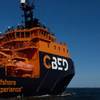Considerable concern has risen in the maritime community regarding impending regulations governing marine diesel emissions. The most immediate of these regulations is part of the MARPOL 73/78 Annex VI of the International Maritime Organization (IMO).
The IMO has proposed a policy on the prevention of air pollution from ships to their 156 member nations. This treaty, much of which deals with large ships, states that NOx emissions should be restricted for smaller vessels as well.
The policy, as drafted, would be effective for vessels whose keels are laid on or after Jan. 1, 2000. It is this deadline and the IMO approval process that has led to some confusion. At the time of this writing the actual treaty has not been ratified by the required 15 members nations representing at least 50 percent of the gross tonnage of world shipping, and ratification is not likely to occur until 2002. Even then, it will not be enforceable until 12 months after ratification. However, once approved local authorities may retroactively enforce the law for all vessels built on or after January 1, 2000. Unlike other industrial and on-highway applications where compliance is the responsibility of the manufacturer, in the marine industry it will be the responsibility of the vessel owner.
The proposed IMO regulations are designed solely to limit Nitrogen Oxide (NOx) emissions to levels on diesel engines above 130kW/174 hp. This includes both main propulsion and auxiliary engines but excludes any on-board emergency generator sets. The next level or Tier II regulations, as planned by the EPA for 2004, will expand the scope to include NOx, hydrocarbons, carbon monoxide and particulate emissions to address both ozone depletion and localized pollution concerns.
Contrary to popular belief, the IMO limits can be met by mechanical engines. There are unique challenges in meeting the marine standards because of the engine being encased in the vessel's hull. Typical land-based diesels are designed with air-to-air after-cooling systems. In the commercial market, the option of using seawater cooling is accompanied by more complex installation and maintenance costs. Exhaust systems on boats, due to the length of run and mufflers for air born noise concerns affecting crew environment, tend to have significantly higher back pressures and hence unique challenges in NOx reduction.
Several engine adjustments and modifications can be incorporated during manufacture to reduce NOx emissions. These include air to fuel ratio adjustments, injector nozzle spray patterns, fuel injection pressures and timing. Typically, by retarding the timing so that combustion occurs later in the cycle there will be a reduction in the NOx emissions accompanied by a slight increase in fuel consumption. In order to strike a precise balance in these variables, test cells where engines are monitored under simulated vessel operating conditions are in constant use. A prime example of a company working to achieve improved performance is Cummins, who is working closely with the EPA and Lloyds Register to obtain Statements of Compliance and to provide customer documentation on the full range of engines certified by January. Such engines will have an identification tag attached, but more importantly, they will be accompanied by the engine's technical file. While the identification tag is not mandatory, an on-board technical file is required per the MARPOL 73/78. It will be the responsibility of the manufacturer to provide and the operator to maintain this technical file with other ship documents for inspection. It is anticipated that in U.S. waters the EPA will delegate such inspections to the Coast Guard.
It is not anticipated that any of these regulations will apply to engines that are remanufactured to the same power output. If a remanufacture results in an increase of ten percent of more of power output, the engine must be made compliant. While the IMO does not make specific reference to vessel conversions the EPA does. It requires that, in the event of a major vessel conversion costing over 50 percent of the vessel's value, the engine must meet IMO standards. As the IMO standards are drafted at present, single engines being replaced on a twin engine boat, will have to be compliant as does any replacement engine. This has created some concern with regard to maintaining a balanced pair of engines.
Many engine manufacturers have enlisted the support of the Engine Manufactures Association (EMA) to represent the collective voice of the marine diesel industry. Explaining that IMO standards will most likely be adopted by many nations in the absence of national standards, EMA spokesman Walt Brown says, "As an industry, we support the IMO objectives, because they are achievable. There is also an advantage in sharing the costs by harmonizing standards throughout the world."
The EMA will continues to work closely with the U.S. EPA to give direction on how to carry out the U.S. program in a manner that is sensitive and timely to the needs of vessel owners and operators.
Sponsored Content
LR - Fit for 55: Managing compliance and optimising operations

Use Roxtec seals, services and software

Subscribe for
Maritime Reporter E-News
Maritime Reporter E-News is the maritime industry's largest circulation and most authoritative ENews Service, delivered to your Email five times per week









